Bhushan B. Nanotribology and Nanomechanics: An Introduction
Подождите немного. Документ загружается.

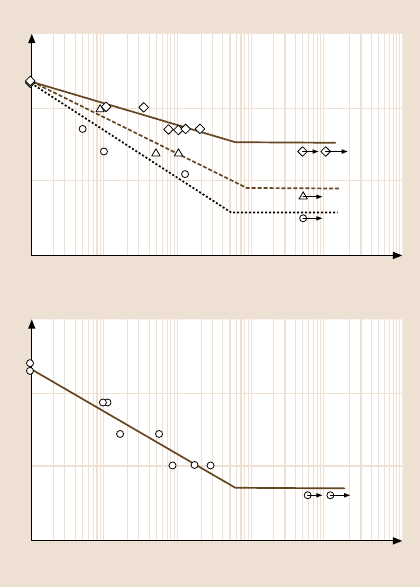
384 Bharat Bhushan
The variation of average crack width and average crack spacing with strain is
plotted in Fig. 8.55. The crack width is measured at a spot along a given crack over
a distance of 1 µminthe5µm scan image at different strains. The crack spacing
is obtained by averaging the inter-crack distance measured in five separate 50µm
scans at each strain. It can be seen that the cracks nucleate at a strain of about 0.7–
1.0%, well within the elastic limit of the substrate. There is a definite change in
the slope of the load–displacement curve at the strain where cracks nucleate and
the slope after that is closer to the slope of the elastic portion of the substrate. This
would mean that most of the load is supportedby the substrateonce the coating fails
by cracking.
Fatigue experiments can be performed by applying a cyclic stress amplitude
with a certain mean stress [63]. Fatigue life was determined by the first occurrence
of cracks. Experiments were performed at various constant mean stresses and with
a range of cyclic stress amplitudes for each mean stress value for various magnetic
tapes. The number of cycles to failure were plotted as a function of stress state to
obtain a so-called S–N (stress–life) diagram. As the stress is decreased, there is
a stress value for which no failure occurs. This stress is termed the endurance limit
or simply the fatigue limit. Figure 8.56 shows the S–N curve for an ME tape and
Maximum stress (MPa)
Number of cycles
10
0
10
5
40
35
30
25
10
1
10
2
10
3
10
4
Maximum stress (MPa)
Number of cycles
10
0
10
5
40
35
30
25
10
1
10
2
10
3
10
4
ME tape
σ
mean
= 30.6 MPa
24.5 MPa
21.4 MPa
ME tape without DLC
σ
mean
= 20.2 MPa
Fig. 8.56. S–N curve for
two magnetic tapes with
maximum stress plotted on
the ordinate and number
of cycles to failure on the
abscissa. The data points
marked with arrows indicate
tests for which no failure
(cracking) was observed in
the scan area, even after
a large number of cycles
(10,000)
8 Nanotribology, Nanomechanics and Materials Characterization 385
an ME tape without DLC. For the ME tape, the endurance limit is seen to go down
with decreasing mean stress. This is consistent with the literature and is because
for lower mean stress the corresponding stress amplitude is relatively high and this
causes failure. The endurancelimit is found to be almost the same for all three mean
stresses. In the case of ME tape without DLC, the critical number of cycles is also
found to be in the same range.
In situ surface characterization of unstretched and stretched films has been used
to measure the Poisson’s ratio of polymeric thin films by Bhushan [120]. Uniax-
ial tension is applied by the tensile stage. Surface height profiles obtained from
the AFM images of unstretched and stretched samples are used to monitor the
changes in displacements of the polymer films in the longitudinal and lateral di-
rections simultaneously.
8.4.5 Nanofabrication/Nanomachining
An AFM can be used for nanofabrication/nanomachining by extending the mi-
croscale scratching operation [4, 13, 27, 65]. Figure 8.57 shows two examples of
nanofabrication.The patterns were created on a single-crystal silicon(100) wafer by
scratching the sample surface with a diamond tip at specified locations and scratch-
ing angles. Each line is scribed manually at a normal load of 15 µN and a writing
speed of 0.5µm/s. The separation between lines is about 50nm and the variation in
line width is due to the tip asymmetry. Nanofabrication parameters – normal load,
scanning speed, and tip geometry – can be controlled precisely to control depth and
length of the devices.
Nanofabrication using mechanical scratching has several advantages over other
techniques. Better control over the applied normal load, scan size, and scanning
speed can be used for nanofabrication of devices. Using the technique, nanofabri-
cation can be performed on any engineering surface. Use of chemical etching or
reactions is not required and this dry nanofabrication process can be used where
the use of chemicals and electric fields is prohibited. One disadvantageof this tech-
nique is the formation of debris during scratching. At light loads, debris formation
is not a problem comparedto high-loadscratching. However, debriscan be removed
easily from the scan area at light loads during scanning.
8.5 Indentation
Mechanical properties on relevant scales are needed for the analysis of friction and
wear mechanisms.Mechanical properties,such as hardness and Young’s modulusof
elasticity can be determined on the micro- to picoscales using the AFM [23,27,44,
50] and a depth-sensing indentation system used in conjunction with an AFM [49,
121–123].
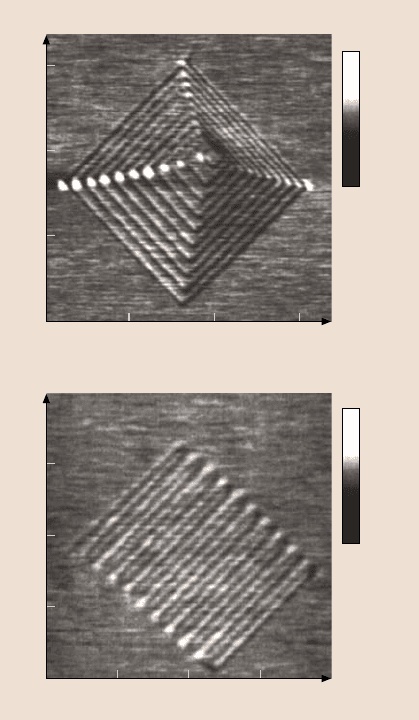
386 Bharat Bhushan
Si(100)
0
1.50
1.00
0.50
0
0.50 1.00 1.50 (μm)
(μm)
0
1.00
0.75
0.50
0.25
0
0.25 0.50 1.00 (μm)
(μm)
0.75
10.0 nm
5.0 nm
0.0 nm
10.0 nm
5.0 nm
0.0 nm
Fig. 8.57. Top Trim and bot-
tom spiral patterns generated
by scratching a Si(100) sur-
face using a diamond tip at
a normal load of 15 µNand
writing speed of 0.5µm/s
8.5.1 Picoindentation
Indentability on the sub-nanometer scale of soft samples can be studied in the
force calibration mode (Fig. 8.6) by monitoring the slope of cantilever deflection
as a function of sample traveling distance after the tip is engaged and the sample is
pushed against the tip. For a rigid sample, cantilever deflection equals the sample
traveling distance, but the former quantity is smaller if the tip indents the sample.
In an example for a polymeric magnetic tape shown in Fig. 8.58, the line in the left
portion of the figure is curved with a slope of less than 1 shortly after the sample
touches the tip, which suggests that the tip has indented the sample [23]. Later, the
slope is equal to 1, suggesting that the tip no longer indents the sample. This ob-
servation indicates that the tape surface is soft locally (polymer-rich) but hard (as
a result of magnetic particles) underneath. Since the curves in extendingand retract-
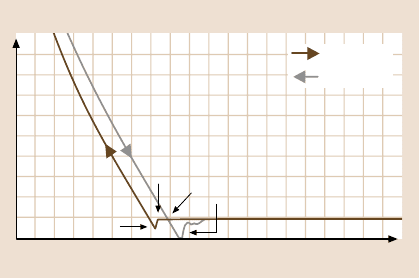
8 Nanotribology, Nanomechanics and Materials Characterization 387
Z position (15 nm/div)
Tip deflection (6 nm/div)
B
D
A
C
Retracting
Extending
Fig. 8.58. Tip deflection (nor-
mal load) as a function of the
z (separation distance) curve
for a polymeric magnetic
tape [23]
ing modes are identical, the indentation is elastic up to the maximum load of about
22nN used in the measurements.
Detection of transfer of material on a nanoscale is possible with the AFM. In-
dentation of C
60
-rich fullerene films with an AFM tip has been shown [48] to result
in the transfer of fullerene molecules to the AFM tip, as indicated by discontinuities
in the cantilever deflection as a function of sample traveling distance in subsequent
indentation studies.
8.5.2 Nanoscale Indentation
The indentation hardness of surface films with an indentation depth as small as
about 1 nm can be measured using an AFM [13, 49, 50]. Figure 8.59 shows the
greyscale plots of indentation marks made on Si(111) at normal loads of 60, 65, 70
and 100µN. Triangular indents can be clearly observed with very shallow depths.
At a normal load of 60µN, indents are observed and the depth of penetration is
about 1nm. As the normal load is increased, the indents become clearer and the in-
dentation depth increases. For the case of hardness measurements at shallow depths
on the same order as variations in surface roughness, it is desirable to subtract the
original (unindented) map from the indent map for accurate measurement of the
indentation size and depth [27].
To make accurate measurements of hardness at shallow depths, a depth-sensing
nano/picoindentation system (Fig. 8.9) is used [49]. Figure 8.60 shows the load–
displacement curves at different peak loads for Si(100). Loading/unloading curves
often exhibit sharp discontinuities, particularly at high loads. Discontinuities, also
referred to as pop-ins, during the initial part of the loading part of the curve mark
a sharp transition from pure elastic loading to a plastic deformation of the speci-
men surface, correspond to an initial yield point. The sharp discontinuities in the
unloading part of the curves are believed to be due to the formation of lateral cracks
which form at the base of the median crack, which results in the surface of the
specimen being thrust upward. Load–displacement data at residual depths as low
as about 1nm can be obtained. The indentation hardness of surface films has been
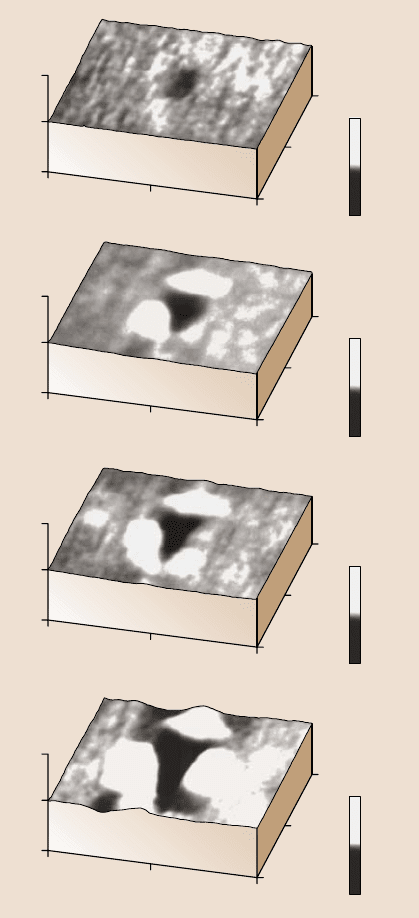
388 Bharat Bhushan
500
0
0
250
500 nm
20.0
40.0
nm
250
0
20.0 nm
0.0 nm
10.0 nm
60 μN,
1.0 nm
500
0
0
250
500 nm
20.0
40.0
nm
250
0
20.0 nm
0.0 nm
10.0 nm
65 μN,
2.5 nm,
16.6 GPa
500
0
0
250
500 nm
20.0
40.0
nm
250
0
20.0 nm
0.0 nm
10.0 nm
70 μN,
3.0 nm,
15.8 GPa
500
0
0
250
500 nm
20.0
40.0
nm
250
0
20.0 nm
0.0 nm
10.0 nm
100 μN,
7.0 nm,
11.7 GPa
Fig. 8.59. Greyscale plots
of indentation marks on the
Si(111) sample at various
indentation loads. Loads, in-
dentation depths and hardness
values are listed in the fig-
ure [50]
measured for various materials including Si(100) up to a peak load of 500 µNand
Al(100) up to a peak load of 2000µNbyBhushan et al. [49] and Kulkarni and
Bhushan [121–123]. The hardnesses of single-crystal of silicon and single-crystal
aluminum on a nanoscale are found to be higher than on a microscale, Fig. 8.61.
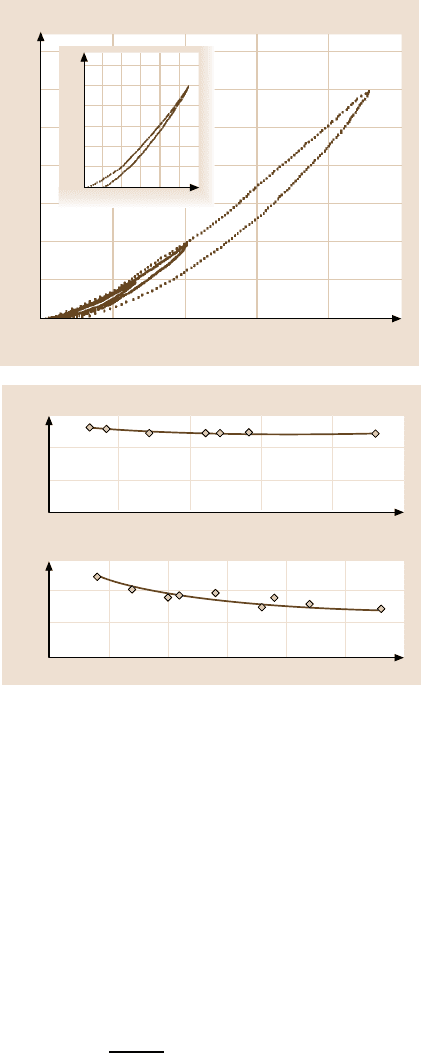
8 Nanotribology, Nanomechanics and Materials Characterization 389
Load (μN)
Displacement (nm)
0
25
350
300
250
200
150
100
50
0
5 101520
Si(100)
0
60
50
40
30
20
10
0
1 2 3 4 56
Fig. 8.60. Load–displacement
curves at various peak loads
for Si(100) [49]
15
10
5
0
0.75
0.5
0.25
0
0 5 10 15 20 25
0 100 200 300
Hardness (GPa)
Residual depth (nm)
Si(100)
Hardness (GPa)
Al(100)
Fig. 8.61. Indentation
hardness as a function
of residual indentation
depth for Si(100) [49], and
Al(100) [121]
Microhardness has also been reported to be higher than that on the millimeter scale
by several investigators. The data reported to date show that hardness exhibits the
scale (size) effect.
During loading, generation and propagation of dislocations is responsible for
plastic deformation. A strain gradient plasticity theory has been developed for
micro/nanoscaledeformations,and is based on randomly created statistically stored
and geometrically necessary dislocations [124,125]. Large strain gradients inherent
to small indentations lead to the accumulation of geometrically necessary disloca-
tions, located in a certain subsurface volume, for strain compatibility reasons that
cause enhanced hardening. The large strain gradients in small indentations require
these dislocations to account for the large slope at the indented surface. These are
a function of strain gradient, whereas statistically, stored dislocations are a function
of strain. Based on this theory, scale-dependent hardness is given as
H = H
0
1+
d
a , (8.22)
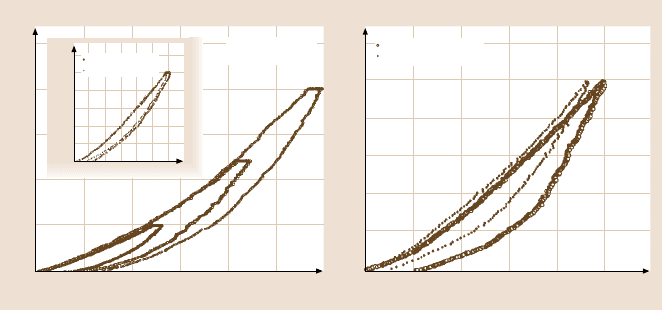
390 Bharat Bhushan
where H
0
is the hardness in the absence of strain gradient or macrohardness,
d
is the material-specific characteristic-length parameter, and a is the contact radius.
In addition to the role of the strain gradient plasticity theory, an increase in hard-
ness with a decrease in indentation depth can possibly be rationalized on the basis
that, as the volume of deformed material decreases, there is a lower probability of
encountering material defects.
Bhushan and Koinkar [44] have used AFM measurements to show that ion im-
plantation of silicon surfaces increases their hardness and thus their wear resistance.
Formation of surface alloy films with improved mechanical properties by ion im-
plantation is of growing technological importance as a means of improving the me-
chanical properties of materials. Hardness of 20-nm-thick DLC films have been
measured by Kulkarni and Bhushan [123].
The creep and strain-rate effects (viscoelastic effects) of ceramics can be stud-
ied using a depth-sensing indentation system. Bhushan et al. [49] and Kulkarni and
Bhushan[121–123]havereported thatceramics (single-crystalsiliconand diamond-
like carbon) exhibit significant plasticity and creep on a nanoscale. Figure 8.62a
shows the load–displacement curves for single-crystal silicon at various peak loads
held for 180s. To demonstrate the creep effects, the load–displacement curves for
a 500µN peak load held for 0 and 30s are also shown as an inset. Note that sig-
nificant creep occurs at room temperature. Nanoindenter experiments conducted by
Li et al. [126] exhibited significant creep only at high temperatures (greater than or
equal to 0.25 times the melting point of silicon). The mechanism of dislocation glide
plasticity is believed to dominate the indentation creep process on the macroscale.
To study the strain-rate sensitivity of silicon, data at two different (constant) rates
of loading are presented in Fig. 8.62b. Note that a change in the loading rate by
a factor of about five results in a significant change in the load–displacement data.
The viscoelastic effects observed here for silicon at ambient temperature could arise
from the size effects mentioned earlier. Most likely, creep and strain-rate experi-
a) b)
Load (μN)
Load (μN)
Displacement (nm)
090
2500
2000
1500
1000
500
0
15 30 45 60 75
0
600
500
400
300
200
100
0
53510 15 20 25 30
Displacement (nm)
060
1200
1000
800
600
400
200
0
10 20 30 40 50
Hold period =30 s
Hold period = 0 s
Silicon (100)
Hold period = 180 s
Load/unload period = 950s
Load/unload period = 180s
Silicon (100)
Fig. 8.62. (a) Creep behavior and (b) strain-rate sensitivity of Si(100) [49]
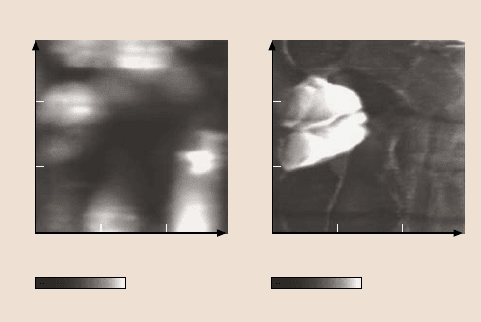
8 Nanotribology, Nanomechanics and Materials Characterization 391
ments are being conducted on the hydrated films present on the silicon surface in
ambient environment, and these films are expected to be viscoelastic.
8.5.3 Localized Surface Elasticity and Viscoelasticity Mapping
The Young’s modulus of elasticity can be calculated from the slope of the indenta-
tion curve during unloading. However, these measurements provide a single-point
measurement. By using the force modulation technique, it is possible to get local-
ized elasticity maps of soft and compliant materials of near-surface regions with
nanoscale lateral resolution. This technique has been successfully used for poly-
meric magnetictapes, which consistof magnetic and nonmagneticceramic particles
in a polymeric matrix. Elasticity maps of a tape can be used to identify relative dis-
tribution of hard magnetic and nonmagnetic ceramic particles on the tape surface,
which has an effect on friction and stiction at the head–tape interface [15]. Fig-
ure8.63 showssurfaceheightand elasticitymaps ona polymericmagnetic tape[54].
The elasticity image reveals sharp variations in surface elasticity due to the compos-
ite nature of the film. As can be clearly seen, regions of high elasticity do not always
correspond to high or low topography. Based on a Hertzian elastic-contact analysis,
the static indentation depth of these samples during the force modulation scan is
estimated to be about 1 nm. We conclude that the contrast seen is influenced most
strongly by material properties in the top few nanometers, independent of the com-
posite structure beneath the surface layer.
By using phase contrast microscopy, it is possible to get phase contrast maps
or the contrast in viscoelastic properties of near-surface regions with nanoscale lat-
eral resolution. This technique has been successfully used for polymeric films and
magnetic tapes which consist of ceramic particles in a polymeric matrix [57–60].
Surface height Elasticity
nm
0
300
300
200
100
0
100 200
nm
0
300
300
200
100
0
100 200
0.0 nm 25.0 nm Compliant Stiff
Fig. 8.63. Surface height and elasticity maps on a polymeric magnetic tape (σ = 6.7nmand
P–V= 32 nm; σ and P–V refer to the standard deviation of surface heights and peak-to-valley
distance, respectively). The greyscale on the elasticity map is arbitrary [54]

392 Bharat Bhushan
TR surface height
0
0
TR amplitude TR phase angle
20 nm
0
1 V
0
180°
0
01 μm1 μm1 μm
Fig. 8.64. Images of an MP tape obtained with TR mode II (constant deflection). TR mode II
amplitude and phase angle images have the largest contrast among tapping, TR mode I and
TR mode II techniques [60]
Figure 8.64 shows typical surfaceheight, TR amplitudeand TR phase-angleim-
ages for a MP tape using the TR mode II, described earlier. TR amplitude image
provides contrast in lateral stiffness and TR phase-angle image provides contrast
in viscoelastic properties. In TR amplitude and phase-angle images, the distribu-
tion of magnetic particles can be clearly seen which have better contrast than that
in TR surface height image. MP tape samples show granular structure with ellipti-
cal shape magnetic particle aggregates (50–100nm in diameter). Studies by Scott
and Bhushan [57], Bhushan and Qi [58], and Kasai et al. [59] have indicated that
the phase shift can be related to the energy dissipation through the viscoelastic de-
formation process between the tip and the sample. Recent theoretical analysis has
established a quantitative correlation between the lateral surface properties (stiff-
ness and viscoelasticity) of materials and amplitude/phase-angle shift in TR meas-
urements [73]. The contrast in the TR amplitude and phase-angle images is due to
the in-plane (lateral) heterogeneity of the surface. Based on the TR amplitude and
phase-angle images, the lateral surface properties (lateral stiffness and viscoelastic-
ity) mapping of materials can be obtained.
8.6 Boundary Lubrication
8.6.1 Perfluoropolyether Lubricants
The classical approach to lubrication uses freely supported multimolecular layers
of liquid lubricants [5,10,15,127]. The liquid lubricants are sometimes chemically
bonded to improve their wear resistance [5, 10, 15]. Partially chemically bonded,
molecularly thick perfluoropolyether (PFPE) films are used for lubrication of mag-
netic storage media because of their thermal stability and extremely low vapor pres-
sure [15].These are consideredas potential candidatelubricantsfor MEMS/NEMS.
Molecularly thick PFPEs are well suited because of the following properties: low
surface tension and low contact angle, which allow easy spreading on surfaces and
provide hydrophobic properties; chemical and thermal stability which minimize
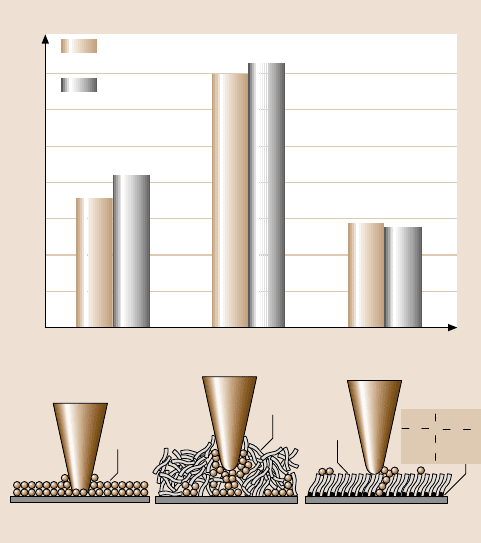
8 Nanotribology, Nanomechanics and Materials Characterization 393
degradation under use; low vapor pressure, which provides low out-gassing; high
adhesion to substrate via organic functional bonds; and good lubricity, which re-
duces contact surface wear.
For boundary lubrication studies, friction, adhesion and durability experiments
have been performed on virgin Si(100) surfaces and silicon surfaces lubricated with
various PFPE lubricants[39,40,42,128].Results of two of the PFPE lubricants will
be presented here: Z-15 (with −CF
3
nonpolar end groups), CF
3
−O−(CF
2
−CF
2
−O)
m
−(CF
2
−O)
n
−CF
3
(m/n ≈ 2/3) and Z-DOL (with −OH polar end groups),
HO−CH
2
−CF
2
−O−(CF
2
−CF
2
−O)
m
−(CF
2
−O)
n
−CF
2
−CH
2
−OH (m/n ≈ 2/3).
Z-DOL film was thermally bonded at 150
◦
C for 30minutes and the unbonded frac-
tion was removed by a solvent (bonded washed or BW) [15]. The thicknesses of
Z-15 and Z-DOL films were 2.8nmand2.3nm, respectively. Lubricant chain diam-
eters of these molecules are about 0.6 nm and molecularly thick films generally lie
flat on surfaces with high coverage.
The adhesive forces of Si(100), Z-15 and Z-DOL (BW) measured by a force
calibration plot and plots of friction force versus normal load are summarized in
100
75
50
25
0
Z-DOL (BW)Z-15Si(100)
Z-DOL
Z-15
Z-15 Z-DOL (BW)Si(100)
H
2
O
22 °C, RH 45–55%
O
Si
O
O
Adhesive force (nN)
Force
calibration plot
Friction
force plot
Fig. 8.65. Summary of the adhesive forces of Si(100) and Z-15 and Z-DOL (BW) films
measured by force calibration plots and friction force versus normal-load plots in ambient
air. The schematic (bottom) showing the effect of meniscus, formed between AFM tip and
the surface sample, on the adhesive and friction forces [42]
